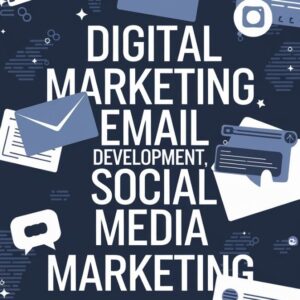Email marketing automation has become a must-have tool for businesses aiming to nurture leads, convert prospects, and engage with customers efficiently. Automation allows marketers to send personalized emails at the right time without manual intervention, resulting in better engagement, higher conversion rates, and improved customer loyalty. In this blog, we’ll explore some essential strategies for leveraging email marketing automation to drive meaningful results.
Table of Contents
ToggleBreak Up Your Audience and Make It More Personal
One of the most powerful features of email marketing automation is the ability to segment your audience into different groups. Audience segmentation allows you to tailor your emails based on specific characteristics like demographics, purchasing behavior, interests, or engagement history. Instead of sending the same email to your entire list, you can deliver highly targeted messages that resonate with different subscriber groups.
For example, a clothing retailer might segment its audience based on past purchases, sending different promotions to people who have shown interest in men’s vs. women’s apparel. This increases the likelihood of recipients finding the content relevant and acting on it. With audience segmentation, you’re not only improving engagement but also increasing the chances of conversions.
Behavioral triggers allow marketers to send emails automatically based on a subscriber’s actions, making the content timely and relevant. Triggered emails are especially powerful because they respond to specific user behavior, such as browsing a product, making a purchase, or abandoning a cart.
For instance, cart abandonment emails are one of the most effective types of triggered emails. If a customer adds items to their cart but doesn’t complete the purchase, you can automatically send a follow-up email reminding them of the items left behind, perhaps with a discount offer to incentivize the sale. These real-time interactions not only boost conversions but also improve customer retention by addressing their specific needs or actions.
Make a series of welcome messages for new subscribers
A well-crafted welcome series is essential for making a strong first impression and establishing a relationship with new subscribers. When someone subscribes to your email list, they’re typically most engaged in those initial moments. Use this opportunity to introduce your brand, set expectations, and offer something of value.
A typical welcome series includes several automated emails sent over a few days or weeks. The first email might thank the subscriber for signing up, while the following emails could offer helpful information, showcase popular products, or provide a special discount. This sequence gradually builds rapport with the new subscriber, increasing the likelihood that they’ll become loyal customers over time.











Drip Campaigns for Lead Nurturing
Drip campaigns are automated sequences of emails sent over time, designed to nurture leads and guide them through the sales funnel. These campaigns are especially effective for businesses with longer sales cycles, as they help keep your brand top-of-mind without overwhelming the prospect with too much information at once.
For example, if someone downloads an eBook from your website, you can set up a drip campaign that sends additional resources, case studies, or product demonstrations over the following weeks. Each email should offer valuable content that moves the recipient closer to making a purchase decision. Drip campaigns can also be used for onboarding new customers, upselling products, or educating users about your services.
A/B Testing for Continuous Improvement
To ensure that your email automation strategies are delivering the best results, it’s essential to regularly conduct A/B testing. This process involves testing different versions of your emails to see which one performs better. You can test subject lines, email copy, call-to-action buttons, images, and even the time of day emails are sent.
For instance, one version of an email might have a subject line that includes the recipient’s first name, while the other version might not. By analyzing which version gets higher open rates, you can refine your future emails based on data-backed insights. Consistent A/B testing helps optimize your email marketing automation, improving key metrics like open rates, click-through rates, and conversions.
Monitor Performance and Optimize
Email automation needs constant optimisation and monitoring, just like any other marketing technique. The majority of email systems offer comprehensive analytics, such as open rates, click-through rates, bounce rates, and conversions, that let you monitor the effectiveness of your campaigns. Utilise this information to pinpoint the regions in which your efforts are performing well and those that require work.
For instance, you might need to change the content or frequency of your emails to better suit the interests of a specific target segment if you observe that they are not responding to them. You can make wise decisions and make sure your email marketing campaigns continue to be successful over time by routinely analysing performance statistics.

CONCLUSION
Email marketing automation is a powerful way to streamline communication, increase engagement, and drive sales. By implementing strategies such as audience segmentation, behavioral triggers, welcome series, drip campaigns, and A/B testing, you can ensure your emails are relevant and impactful. Regular monitoring and optimization are key to long-term success, allowing you to fine-tune your campaigns and achieve better results over time. When done correctly, email automation not only saves time but also significantly boosts your marketing efforts, leading to higher conversions and stronger customer relationships.

Add a Comment